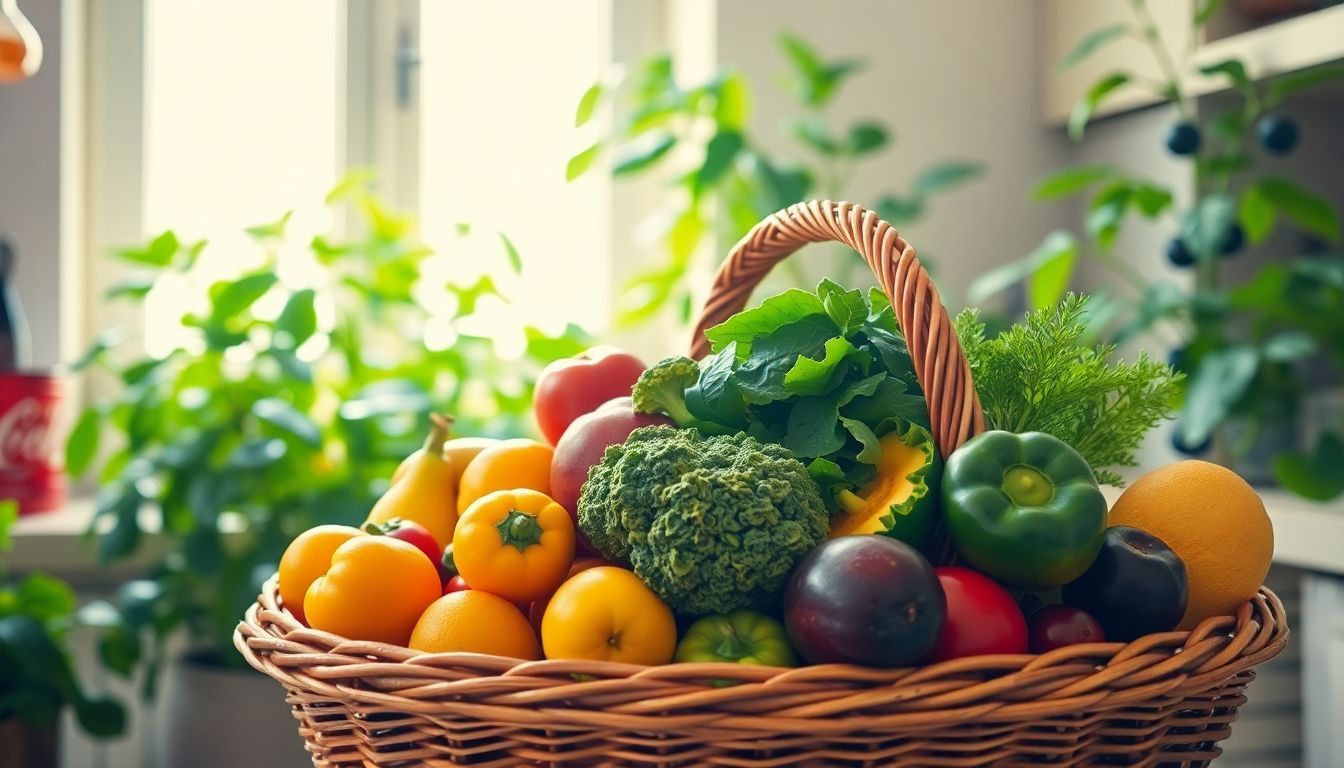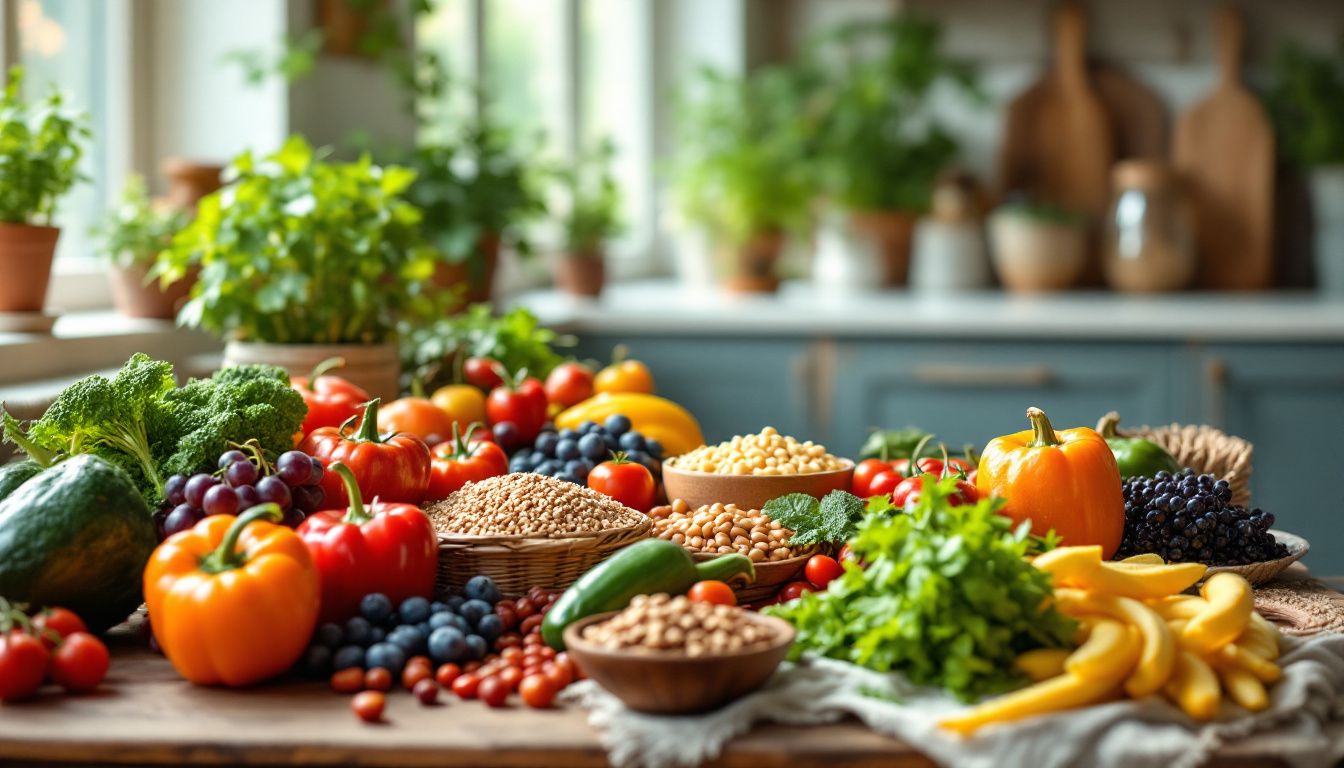Struggling with digestion or feeling sluggish? Fiber is a key nutrient that keeps your digestive system running smoothly. This article will show you the best high-fiber foods to add to your meals and snacks.
Thank you for reading this post, don't forget to subscribe!Stick around—your gut will thank you!
Key Takeaways
- Adults need 25 grams of fiber daily for women and 38 grams for men, but most eat only about 15 grams.
- High-fiber foods like lentils (13.1g per cup), raspberries (8g per cup), and chia seeds (9.75g per ounce) boost gut health and help prevent constipation.
- Soluble fiber lowers cholesterol and regulates blood sugar; insoluble fiber adds bulk to stools for better digestion. Both are vital in a balanced diet.
- Whole grains like oats or barley, vegetables like Brussels sprouts, and fruits such as pears provide quick ways to increase dietary fiber intake.
- A high-fiber diet supports heart health, weight management, stable blood sugar levels, and reduced risk of chronic diseases like type 2 diabetes or heart disease.
Understanding Fiber in Your Diet
Fiber plays a key role in keeping your body healthy. It improves digestion and supports overall gut health.
Types of Fiber
There are two main types of dietary fiber: soluble and insoluble. Soluble fiber dissolves in water, forming a gel-like substance. Foods like oats, legumes, barley, and some fruits contain this type.
It helps lower cholesterol levels and control blood sugar. Insoluble fiber does not dissolve—think of it as roughage that keeps your digestive system moving. You’ll find insoluble fibers in whole grains, certain vegetables like broccoli or Brussels sprouts, nuts, and seeds.
Each has unique benefits for gut health and overall wellness. While soluble fibers slow digestion to improve nutrient absorption, insoluble ones prevent constipation by adding bulk to stools.
Both types work together for a balanced diet recommended by dietary guidelines for Americans.
Recommended Fiber Intake for Adults
Adults should aim for a fiber intake of 25 grams daily for women and 38 grams for men. Many fall short, consuming about 15 grams each day. Meeting these numbers is key to supporting gut health and digestion.
Adding high-fiber foods like lentils, black beans, oats, or Brussels sprouts can close the gap. Soluble dietary fiber controls cholesterol levels and blood sugar. Insoluble dietary fiber promotes healthy bowel movements.
Drink water with your high-fiber diet to avoid constipation. Gradual changes are easier on your digestive system!

Top High-Fiber Foods
Eating foods with fiber helps your body stay healthy. From beans to fruits and grains, there are many tasty options to explore for better digestion and energy.
Legumes: Lentils, Black Beans, Chickpeas
Lentils, black beans, and chickpeas pack a fiber punch. Cooked lentils offer 13.1 grams of fiber per cup, making them an excellent choice for boosting daily intake. Black beans add 8.7 grams of fiber in just 100 grams and are great for soups or tacos.
Chickpeas provide 12.5 grams of fiber per cooked cup while also being rich in plant-based protein.
These legumes do more than aid digestion—they help with weight management and improve gut health by supporting healthy gut bacteria. They’re also packed with iron, folate, and other nutrients that promote energy levels and overall health.
Try adding them to salads, stews, or even Middle Eastern cuisines like hummus for easy ways to enjoy their benefits!
Fruits: Pears, Apples, Raspberries
After enjoying legumes, turn to high-fiber fruits like pears, apples, and raspberries. A medium pear offers about six grams of fiber—perfect for meeting your daily fiber intake. Apples provide around four grams per fruit, depending on their size.
They also help with weight loss and blood sugar management thanks to their soluble fiber.
Raspberries shine as a top pick among high-fiber foods. One cup contains eight grams of dietary fiber! Adding these berries to oatmeal or yogurt improves gut health and supports digestion.
These fruits are easy snacks that fit into any meal plan for a healthier diet.
Vegetables: Broccoli, Sweet Potatoes, Brussels Sprouts
Fruits pack fiber, but vegetables like broccoli, sweet potatoes, and Brussels sprouts are just as powerful. Broccoli is loaded with dietary fiber, vitamin C, potassium, and folate.
It helps your digestive system stay healthy and supports weight control. Sweet potatoes are a tasty option too. A medium-sized boiled one offers about 3.8 grams of fiber along with beta carotene to promote eye health.
Brussels sprouts deserve attention too. One cup of these green powerhouses gives you 3.3 grams of fiber while delivering vitamin K and potassium for bone strength and heart support.
These high-fiber foods also help in blood sugar management and lower risks for chronic diseases like type 2 diabetes or heart disease—making them excellent choices for a well-balanced diet!

Whole Grains: Oats, Whole Wheat Pasta, Barley
Oats, whole wheat pasta, and barley pack a fiber punch. They are high in both soluble and insoluble fiber. Oats contain beta glucan, which helps lower cholesterol and manage blood sugar levels.
A cup of cooked oats has about 4 grams of dietary fiber.
Whole wheat pasta is better than refined grains like white rice or regular pasta. It keeps the bran and germ intact for more nutrients. One cup can give you around 6 grams of fiber.
Barley adds a chewy texture to soups or salads while delivering about 6 grams of fiber per cooked cup!
Nuts and Seeds: Almonds, Chia Seeds, Flaxseeds
Almonds deliver 4 grams of fiber per 3 tablespoons, making them a tasty high-fiber snack. They also supply healthy fats and assist in weight management. Chia seeds provide even more fiber—9.75 grams per ounce! These tiny seeds help improve digestion and manage cholesterol levels.
Flaxseeds are another excellent choice for increasing daily fiber intake. Adding them to oatmeal, smoothies, or salads is simple and beneficial for gut health. Nuts and seeds like these satisfy hunger while also promoting heart health and helping to regulate blood sugar.
Benefits of a High-Fiber Diet
Eating fiber-rich foods helps keep your digestive system healthy. It can also support better overall health and wellness in many ways—making it worth adding to your meals daily!
Aids in Digestion and Prevents Constipation
Fiber helps your digestive system run smoothly. Soluble fiber forms a gel in your gut, slowing digestion and keeping you full longer. Insoluble fiber adds bulk to stool and keeps things moving through the large intestine.
Together, they support gut health and prevent constipation.
Most people don’t eat enough daily fiber. Women need 25 grams a day; men should aim for 38 grams. High-fiber foods like kidney beans, sweet potatoes, chia seeds, and whole-wheat pasta can help meet these numbers.
Drinking water with high-fiber meals makes digestion easier too!
Helps Control Blood Sugar Levels
High-fiber foods, like lentils, quinoa, and almonds, help regulate blood sugar. Soluble fiber slows digestion, preventing sharp spikes in sugar levels while keeping energy stable. These foods are perfect for managing blood sugar throughout the day.
A diet rich in whole grains, vegetables like sweet potatoes or Brussels sprouts, and high-fiber snacks can maintain healthy glucose levels. Stable sugars reduce risks linked to diabetes and improve overall gut health.
Reduces Risk of Heart Disease
Fiber helps lower cholesterol levels. Soluble fiber, found in oats and beans like black beans, binds to cholesterol in the digestive system. This prevents it from entering your bloodstream.
Lower cholesterol means a healthier heart and reduced risk of heart disease.
Eating fiber-rich foods keeps blood sugar steady. Stable sugar levels reduce strain on the heart over time. Whole grains, sweet potatoes, and fruits like apples all support better heart health while also keeping you feeling full longer.
Supports Weight Management
Eating high-fiber foods helps you feel full longer. This reduces overeating and supports weight loss efforts. Foods like lentils, quinoa, and sweet potatoes are great choices for staying satisfied while managing your calorie intake.
The daily fiber intake is 25 grams for women and 38 grams for men, but most Americans only eat about 15 grams per day. Adding vegetables like broccoli or fruits such as pears to meals can help boost this number—and improve overall weight management.

Tips for Increasing Fiber in Your Diet
Adding more fiber to your meals can improve digestion and boost overall health—find easy tips to make it part of your daily routine.
Incorporate Fiber at Every Meal
Start breakfast with instant oatmeal or whole-wheat toast. Add chia seeds or flaxseeds for extra fiber. Include fruits like pears or raspberries on the side. These simple choices give your morning a healthy boost.
For lunch, try lentil soup or a salad filled with leafy greens, kidney beans, and sunflower seeds. Add guacamole for flavor and healthy fats. At dinner, swap white rice for brown rice or barley.
Pair it with roasted Brussels sprouts or sweet potatoes to pack in more fiber-rich foods.
Choose Whole Grains Over Refined
Whole grains keep their bran and germ, making them high in fiber and nutrients. Refined grains like white rice lose these parts during processing. A cup of cooked brown rice has about 3.5 grams of fiber, while white rice has less than 1 gram.
Choosing whole wheat pasta or barley instead boosts fiber intake and helps digestion.
High-fiber foods like oats or whole-grain cereals can support weight management by keeping you full longer. Health experts recommend adults get 25-38 grams of daily fiber, but most fall short.
Whole grains make it easier to meet this goal without extra effort at meals… Next up—easy ways to snack on nuts and fruits!
Snack on Nuts and Fresh Fruits
Nuts and fresh fruits are packed with dietary fiber and healthy fats. Roasted almonds or chia seeds can curb hunger while providing both soluble and insoluble fiber. Pears, apples, and bananas make quick snacks that also promote gut health.
Bananas, in particular, help improve water absorption in the colon—this eases digestion.
Avocados bring a creamy twist to meals while boosting your daily fiber intake. If you crave crunchy treats, spiced nuts offer flavor but eat them moderately—they’re calorie-dense! Combine banana slices with yogurt for a parfait rich in nutrients and high-fiber goodness.
Add Legumes to Salads and Soups
Legumes like lentils, black beans, and chickpeas are perfect for salads and soups. They boost fiber intake while adding texture and flavor. A half-cup of cooked black beans has about 7.5 grams of fiber—great for gut health.
Lentils and kidney beans offer similar benefits too.
Tossing green peas or chickpeas in a salad can make it filling. Split peas in soup provide plant-based protein along with fiber. These pods help prevent constipation and keep blood sugar steady.
Use legumes to support weight management—they help you feel full longer! Mix different types to add variety to your meals without extra effort.
FAQs
Got questions about fiber? These answers can help you make better food choices and meet your daily goals.
What food is highest in fiber?
Lentils and split peas are some of the highest-fiber foods. A cup of cooked lentils contains about 15 grams of fiber, while a cup of split peas has around 16 grams. These legumes also provide plant-based protein, making them a nutritious option.
Raspberries stand out among fruits with 8 grams of fiber per cup. For grains, wheat bran is exceptional—it offers about 25 grams per cup. Chia seeds top the list for seeds, packing around 10 grams in just two tablespoons.
Adding these to your diet can help meet the recommended daily fiber intake.
How can I get 30g of fiber a day?
Start your day with a bowl of oats topped with chia seeds and raspberries. This can provide around 10 grams of dietary fiber. For lunch, have a salad with chickpeas, broccoli, and sunflower seeds—this adds another 12 grams.
Snack on an apple or a handful of almonds in the afternoon for about 5 more grams. At dinner, enjoy lentils or black beans alongside sweet potatoes for at least another 8 grams. By combining these high-fiber foods throughout the day, reaching 30 grams becomes simple and satisfying!
Conclusion
Adding fiber to your meals can change your health for the better. High-fiber options like fruits, vegetables, whole grains, and legumes support digestion and heart health. They also help control weight and sugar levels.
Start small—more fiber each day makes a big difference! Make these tasty choices part of your routine today.
Discover how to complement your high-fiber diet by exploring our guide on incorporating iron-rich foods into a healthy diet.
